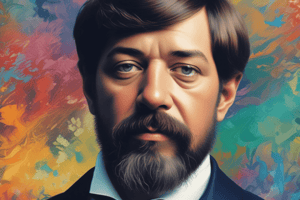Podcast
Questions and Answers
Who is the proponent of the impressionist movement?
Who is the proponent of the impressionist movement?
Claude Debussy
What is the defining feature of expressionism in music?
What is the defining feature of expressionism in music?
High level of dissonance and subjectivity
What scale divides the octave into equal major/minor systems?
What scale divides the octave into equal major/minor systems?
- Chromatic scale
- Major scale
- Whole-tone scale (correct)
- Pentatonic scale
Which of the following is characterized by a high level of dissonance and extreme contrasts?
Which of the following is characterized by a high level of dissonance and extreme contrasts?
What is the title of Debussy's only opera?
What is the title of Debussy's only opera?
What does Aleatoric music involve?
What does Aleatoric music involve?
Which composer is associated with using the 12-tone scale?
Which composer is associated with using the 12-tone scale?
What is EDM known for?
What is EDM known for?
Flashcards are hidden until you start studying
Study Notes
Music Class Overview
- Opening prayer emphasizes focus, inspiration, and guidance for learning.
Impressionism (1890-1920)
- A French artistic movement characterized by unique harmonic language and atmospheric effects.
- Features include ambiguous melodies, innovative chords, and slight dissonances.
Key Elements
- Extensive colors and effects accentuate melodic suggestions.
- Whole-tone scale creates fluidity by dividing the octave.
- Pentatonic scale results when playing black keys on the piano.
- Escape chords suggest a departure to another tonality.
Notable Composers
- Claude Debussy is the main figure, contributing around 227 works, including orchestral and vocal music.
- "Pelléas et Mélisande" (1902) is Debussy's seminal opera.
Expressionism (1918-1930)
- Originated in Germany as a reaction to Impressionism, focusing on subjective expression and emotional intensity.
Key Elements
- Characterized by high levels of dissonance and extremes in dynamics and textures.
- Utilizes a 12-tone scale developed by Arnold Schoenberg.
- Features include distorted melodies, angular shapes, and no conclusive cadences.
Notable Composers
- Arnold Schoenberg shifted towards atonal music, emphasizing chromatic harmony.
- "Moses & Aaron" (1932) is Schoenberg's unfinished three-act opera.
- Igor Stravinsky, a pivotal figure in 20th-century music known for "The Rite of Spring" (1913), blending ballet with orchestral ideas.
Electronic Music
- Emerged in the 1960s, gaining popularity in the 1970s with the introduction of synthesizers and magnetic tape recording.
Key Tools
- Digital instruments and circuitry-based technologies revolutionized music creation and performance.
Aleatoric Music
- Refers to compositions emphasizing elements of chance and unpredictability.
- John Cage's "4'33"" exemplifies this genre, focusing on silence and environmental sound.
Electronic Dance Music (EDM)
- A genre produced by DJs that mixes various styles such as techno, house, and trance.
- Emerged in the mid-1980s, highlighting advances in electronic music technology.
Closing Prayer
- Acknowledgement of accomplishments and the aspiration for continuous inspiration through learning.
Studying That Suits You
Use AI to generate personalized quizzes and flashcards to suit your learning preferences.




